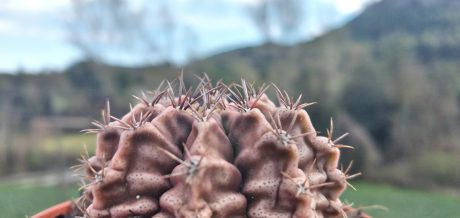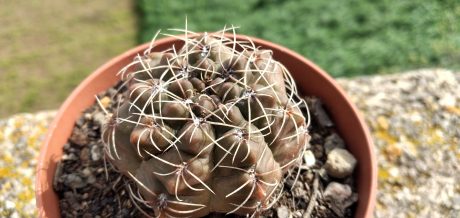Today I present you with one of the cacti that seems to me to be best known for being a variety used by grafts rather than by its scientific name. It is the Gymnocalycium mihanovichii, from Paraguay, between Brazil and Argentina. Those who know it say that one of their common names is ruby ball, because of the color they sometimes have.
It is considered a dwarf cactus, as it hardly exceeds four centimeters in height by six in diameter. The stem is spherical and may be greyish green or green with red hues. It has between eight and ten ribs heavily marked with oval hares with a center covered with white wool. The ribs are covered with spine-like hairs, and are virtually ornamental.
As I said earlier, they are used for grafting, and the feet are usually the variety Hylocereus (or triangular cactus). When you make this genetic change, it’s still mutations that are unable to take photosynthesis or produce chlorophyll, and with the absence of chlorophyll, what they do is that the bodies of these cacti have such strange colorations as yellow, red or dark purple. It is the foot that is responsible for meeting all of their needs, notwithstanding the fact that this graft will last for no more than two or three years.
As for the flowers, it produces between four and six, about five centimeters long, and is shaped like a funnel. They can be yellow or olive and generally hard two to three days, then leave way for a small ovoidal fruit that contains the precious black seeds.
They require direct sunshine to have the shape that they have, on the contrary, if you have it in a place either inside your house or outside where it doesn’t have enough solar radiation, it will deform by looking for light. Contrary to what some of you might think, it’s very resistant to frost, as we can expose it to minimum temperatures of up to five degrees negative, as long as it’s dry and there’s not much ambient humidity.
Finally, the irrigation must be moderate especially when it is a time of flowering, which means once a week in summer, once every fortnight in spring, once a month in autumn and completely abolishing water when the cold comes, or when the minimum temperatures are below five degrees positive. We have to let the substrate dry between irrigation and irrigation, otherwise if it is too moisture and we water again we will take it to root stinking and then death.









Reviews
There are no reviews yet.